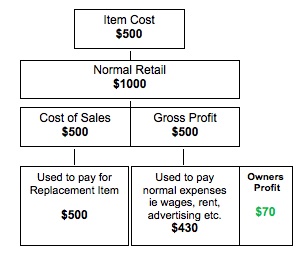Articles and News
The Real Cost of Discretionary Discounting & How to Reduce It | May 08, 2019 (0 comments)

Omaha, NE—Did you know that by giving your ‘good customers’ a 10% discretionary discount, you make absolutely no profit out of the sale ? You don’t even cover costs! (Note: "Discretionary" is when the salesperson chooses to give the customer a discount as opposed to a planned promotion or agreed aged-inventory discount.) (Image at left: IncSmart.biz)
Here’s an example based on a $1,000 item with a 100% markup (keystone) sold at the full retail price:

Now here’s an example based on the same $1,000 item sold at a 10% discount to a ‘good customer':

In fact, not only is there no profit, but you now need to make upthe $30 shortfall! Everyone gets paid except you. The staff, the landlord, the vendor, the advertising company, the bank--and you even paid the customer $100!
Are you shocked? So how can you change that when “everyone asks for discount nowadays.” At least that’s what thousands of retail salespeople keep telling me.
Every time the subject of discounting comes up in one of our seminars it evokes lively discussion. Here’s how the conversation generally goes:
- Q: “Do you consider yourselves to be normal?” This normally gets a “yes”.
- Q: “How many of you generally ask for a discount when you shop?” Normally a third of the audience will say yes to this.
- Q: “So is it reasonable to assume that a third of your customers ask you for a discount, not everyone?” This gets another yes.
- Q: “Those of you who do ask for a discount, how many of you ask for a discount on something you either don’t like or want?” This normally gets a confused look followed by "no, why would you?"
- Q: “So what can we take from that as far as your customers are concerned?” That they either like or want the item.
- Q: “So who’s in the box seat now?” We are because we know they want it.
- Q: “Back to those of you who do ask for a discount, how many of you would buy it anyway if the salesperson just said no?” Normally half of the room say they would, so we are now down to about 16% of the population still looking for something.
- Q: “For those of you who wouldn’t buy it at that stage, how many of you would buy it if the salesperson offered you an alternative to a discount such as an extended warranty, free batteries or cleaning, store currency etc?”
Note: It’s important to ask this with expectation. For example,“I can do much better than a discount!” and then once you’ve told them what you will do, say “and I’m sure you’ll agree that’s better than a discount.” Normally half of those left say they would take it--so we are now down to about 8% of the population still looking for something off the price.
It is now that ‘selling skills’ get replaced by ‘negotiating skills’. The customer has already made the decision to buy, it so it’s just a matter of how much they end up paying for it. The 8% that are left are keen, hardened negotiators. They will be disappointed if you give in too easily.
Negotiation 101. When it comes down to the last 8% of people, it can be effective to ask them “what did you have in mind?” You’ll be surprised how well this works and how reasonable they are.
Always negotiate some more. “I doubt that I can do it for that, but let me see what I can do for you.” Go out the back, have some coffee, pretend to be looking at the price, and then come back with your counter offer.
“As I thought, I can’t do it for $x. The best I can do it for is $y. Make sure the amount is unusual i.e. if the starting price was $895 offer it to them for $854.70. It isn’t a percentage reduction or just $50 off; it looks like you’ve carefully considered it. If they counter offer, negotiate some more. Say something like, “I can’t reduce the price any further, but what I can do is still offer you the extended warranty.”
Remember, these people like to haggle and if you give too easily or too quickly they will be disappointed--and will still feel there was more they could have got.
Action Steps:
- Show your staff the impact a 10% discount has on profitability
- Try this exercise with your staff and help them find ways to deal with it
- Monitor discounts every day and ask ‘why’.
- Watch your profits grow.
The Edge Retail Academy provides customized strategies for retailers and vendors to increase profits, optimize growth, reduce debt, create profitable inventory solutions, build effective teams and enhance brand loyalty and profitability. The Academy is committed to helping jewelry businesses improve their bottom line while reducing uncertainty and stress. Edge Retail Academy software and business advisors provide real world knowledge and advice for guaranteed results, all on a “no-contract” basis. 877-569-8657, ext.1, Becka@EdgeRetailAcademy.com or www.edgeretailacademy.com







